I want to introduce you to one of the most helpful foods you can eat: Fermented foods.
Our gut bacteria is made up of literally thousands of different strains of good bacteria. Keeping this bacteria diverse and plentiful is crucial to preventing anxiety and depression, losing weight, killing candida, sleeping well, and having an abundance of energy.
When you take a probiotic, at best you get thirty different strains of good bacteria—not a lot. And if you take that probiotic over and over again, you never add to the diversity of your microbiome. This is why I encourage you to try adding fermented foods into your diet.
If you want a healthy gut, you are going to need to start eating a variety of fermented foods.
Here are some of my favorite and the best fermented foods:
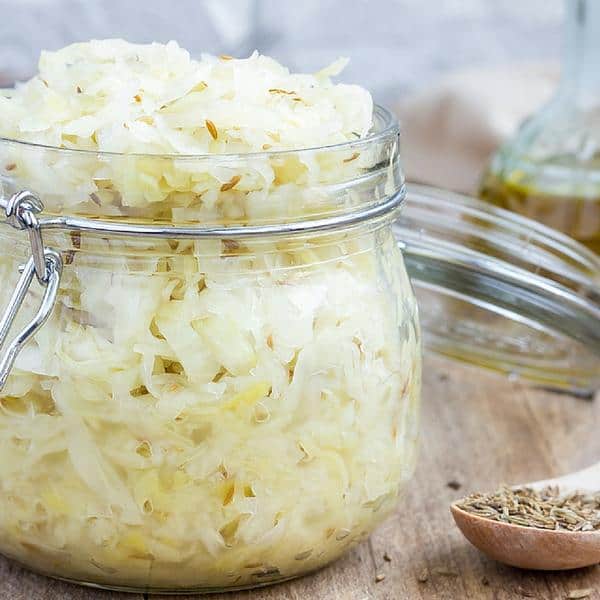
Sauerkraut
This food is simple to make, tasty to eat, and packed with trillions of good bacteria—a must for anyone who is serious about repairing their gut.
Sauerkraut is a fermented cabbage that has been popular throughout central Europe for hundreds of years. It combines one of the healthiest foods there is—cabbage—with one of the most beneficial and time-honored food preparation methods ever used: fermentation.
I kid you not: a daily dose of this cabbage treat will repair your gut quickly and many times better than the strongest probiotic. But before you rush out and grab a jar of Bubbie’s sauerkraut, make sure your sauerkraut is unpasteurized. Just like milk, when you pasteurize sauerkraut, you kill all the good bacteria.
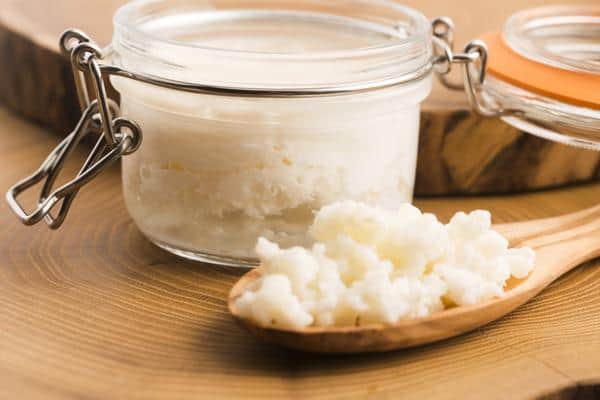
Raw Kefir
Raw kefir is another probiotic-rich food you don’t want to miss out on. Kefir is a unique cultured dairy product that is one of the most probiotic-rich foods on the planet. It has incredible medicinal benefits for healing issues like leaky gut. Its unique name comes from the Turkish word keif, which means “good feeling.” For centuries, it has been used in European and Asian ancient medicine due to the wide variety of conditions it has been known to cure.
Kefir is fermented milk (cow, goat, or sheep milk). It tastes sour like yogurt but goes down more like milk. I like to put it in my smoothies, as it’s high in B12, calcium, magnesium, vitamin K2, biotin, folate, enzymes, and of course, probiotics.
Kefir is known to do the following:
- Boost immunity
- Heal inflammatory bowel disease
- Improve lactose digestion
- Kill Candida
- Build bone density
- Fight allergies
Support detoxification It is the perfect food to add to your diet while on the 45-Day Reset. The one thing to be careful about with kefir is to make sure it’s raw and has no added sugar. You’ll find many yummy kefirs in your local health food store that appear to be healthy, but when you look closer, you’ll see that they’re packed with sugar and pasteurized, which means all the beneficial probiotics have been killed.

Kombucha
Surely you have heard of this hot new drink—you can find it everywhere. Kombucha is made from a sweetened tea that has been fermented by a symbiotic colony of bacteria and yeast called a SCOBY, or “mother.”
It’s packed with probiotics—not as many as kefir or sauerkraut, but it’s still a great way to get a healthy dose of good diverse bacteria. And although kombucha starts off with yeast and sugar, the finished drink actually contains no yeast and very little sugar. In fact, one of its claims to fame is killing candida.
This “health elixir” has been around for more than two thousand years and has a rich anecdotal history of health benefits, like preventing and fighting cancer and combating arthritis and other degenerative diseases. Easy to make at home, easy to find in your local supermarket, high in good probiotics, and low in sugar makes this drink a perfect complement to your 45-Day Reset.
Here are some of the other benefits kombucha has a reputation for helping:
- Detoxification
- Joint care
- Digestion and gut health
- Immune system booster
What you need to look for when buying kombucha is the sugar content, as some kombuchas are higher in sugar than others. Keep your amount of sugar down, under 5 grams per bottle.
Many of you have sat down with me and had nutritional consultations. I often test the diversity of a person’s gut bacteria to see if they have had too much bad bacteria or yeast. When I discover that the microbiome is the source of a patient’s symptoms, I will immediately put them on a high fermented foods diet.
Food can heal. Especially when you know which ones your body needs. Try getting a healthy does of sauerkraut daily or reach for a kombucha in the afternoon instead of your coffee.
The other great thing about fermented foods is you can make it yourself. When the RF Kitchen cookbook is released in September, there will be several fermented foods recipes included.
If you want to get started with a good sauerkraut recipe now, below is one of my favorite recipes that Bonnie, our RF Chef, has included in the new book.
Cheers to a healthy microbiome!
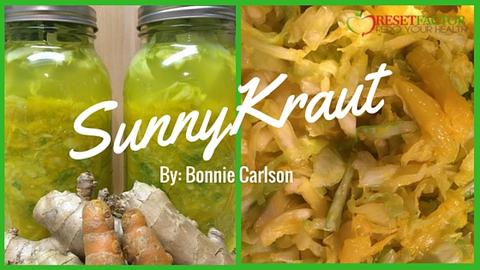
SunnyKraut
YIELD: 14 Cups,
CARBS: 0 Carbs per 1 oz. serving (2 tablespoons)
PREP TIME: 30 minutes
FERMENTATION TIME: 5-7 days
INGREDIENTS:
2 heads green cabbage, shredded
1 whole fresh pineapple, chopped
1/3 cup fresh tumeric, finely grated
1/3 cup fresh ginger, finely grated
2 tablespoons sea salt
2 tablespoons apple cider vinegar
ADDITIONAL BRINE:
1 tablespoon water
1 teaspoon sea salt
1 teaspoon apple cider vinegar
DIRECTIONS:
1. Pull 4 to 5 large leaves off of one of the heads of cabbage and set aside. Shred the remaining cabbage When shredding cabbage, I prefer the control that a sharp chef’s knife gives me, but you can also use a food processor or mandolin. I like using a fine rasp grater for the ginger and turmeric.
2. Mix the shredded cabbage, turmeric, ginger, salt, and vinegar in a large bowl (I prefer a stainless steel bowl, because the turmeric won’t stain it bright yellow, as it will my hands). Wear gloves and massage the cabbage mixture with your hands until it breaks down and starts to soften (5 to 10 minutes); then let it sit for 20 to 30 minutes to give it time to continue to macerate and release more juices.
3. Massage the mixture for another 5 to 10 minutes.
4. With a large long-handled spoon, pack the cabbage mixture into two 36-ounce mason jars. Pack the mixture in tightly all the way down to the bottom. You want the mixture to be submerged in brine (the natural juices create through the maceration process). Leave about 1½ inches of space from the top of the jar.
5. Typically, I need to make additional brine. This is done by combining 1 teaspoon of sea salt with 1 cup of water and 1 tablespoon of apple cider vinegar. Continue to add brine until the cabbage mixture is submerged.
6. Roll up the cabbage leaves you set aside and place them in the jar to push the cabbage under the brine. Screw on the jar loosely so gas can escape as fermentation takes place. Set on the counter for 5 to 14 days in a cool, shaded place. During fermentation, the sauerkraut will bubble a little and become cloudy. If scum or mold appears at the top or on the whole cabbage leaves, remove and discard; replace these with new cabbage leaves to keep the cabbage submerged.
7. Taste the sauerkraut every day and, when you like the flavor, remove the rolled-up cabbage leaves and place the sauerkraut in the refrigerator, which slows down the fermentation process.
TIPS & TRICKS:
Wear gloves and clothes that can get stained when making this recipe; the turmeric juice will stain your hands and could permanently stain your clothes. The pineapple gives this sauerkraut a refreshingly different flavor. Fruit such as pineapple can accelerate the fermentation process and might take less time to achieve a flavor of your liking. After 5 to 6 days, the sauerkraut is crunchy and deliciously fresh. After about 10 days, the flavor gets a little more tart and the texture is softer. This sauerkraut is the perfect accompaniment for a breakfast dish.


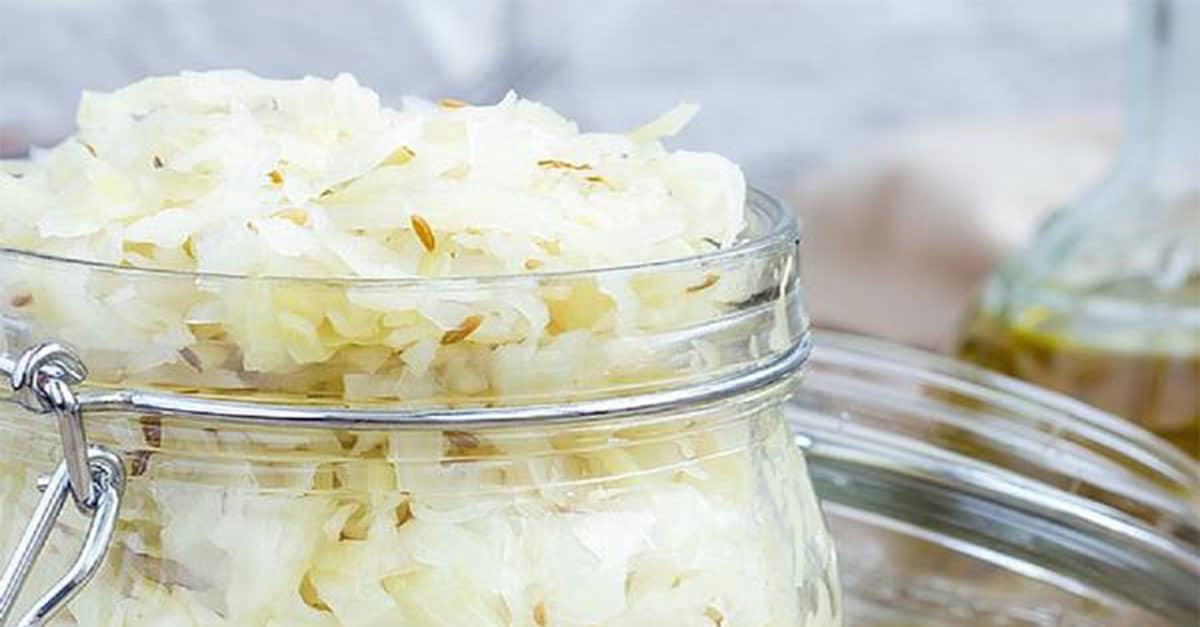

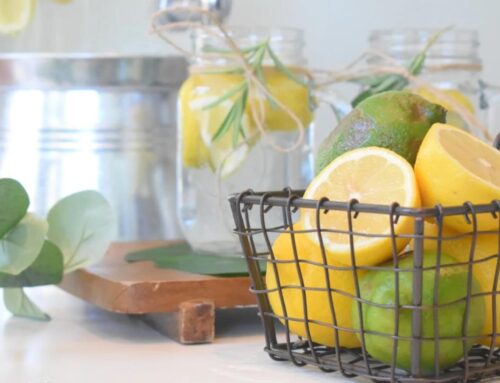


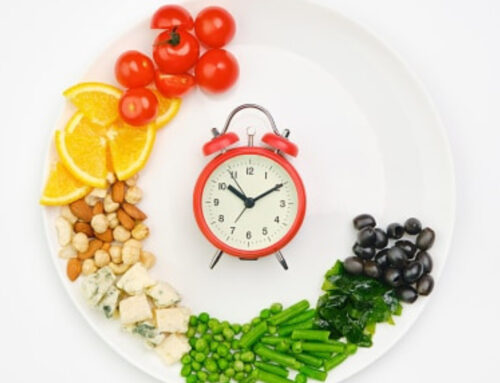

Thanks so much for the advice about fermented foods! I started with sauerkraut today and will be adding the others as soon as I can get them.
Is it common to get headaches when adding fermented foods to our diet? Ever since starting this journey 4 weeks ago I have noticed almost a daily headache and am wondering if it is connected to the fermented foods. How do you fight this?
I plan on making your recipe but am wondering if there an error in the ingrédients for additional brine that immediately follows your sunny kraut ingrédients ?
Hi,
Does eating sauerkraut offer the same health benefits as drinking the juice?
Thanks!
Cindy
How long will this stay good in the fridge?
Just re-read the recipe – when does the pineapple get added?